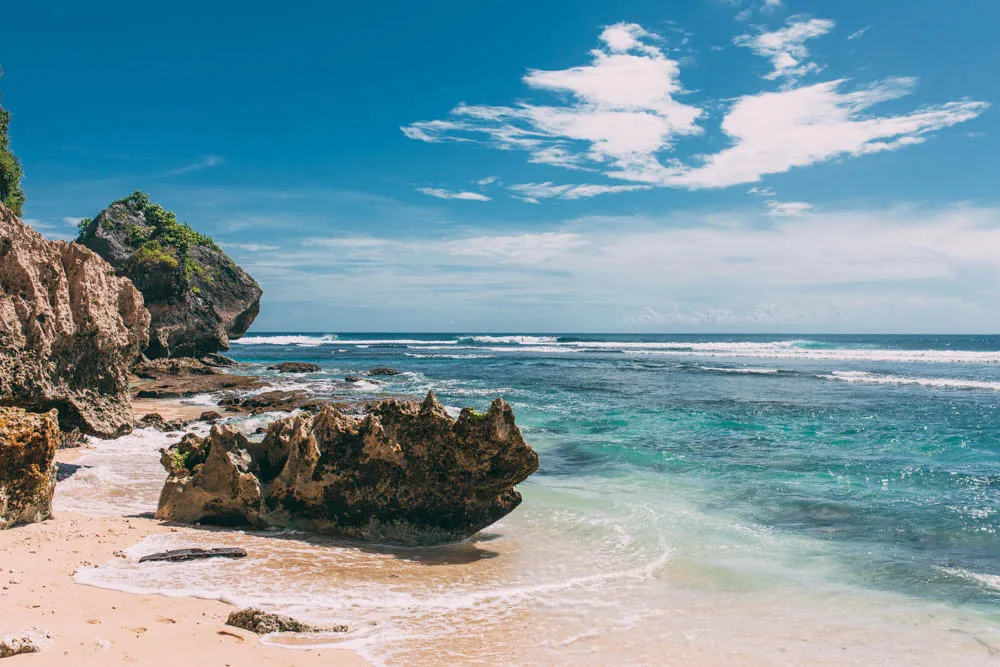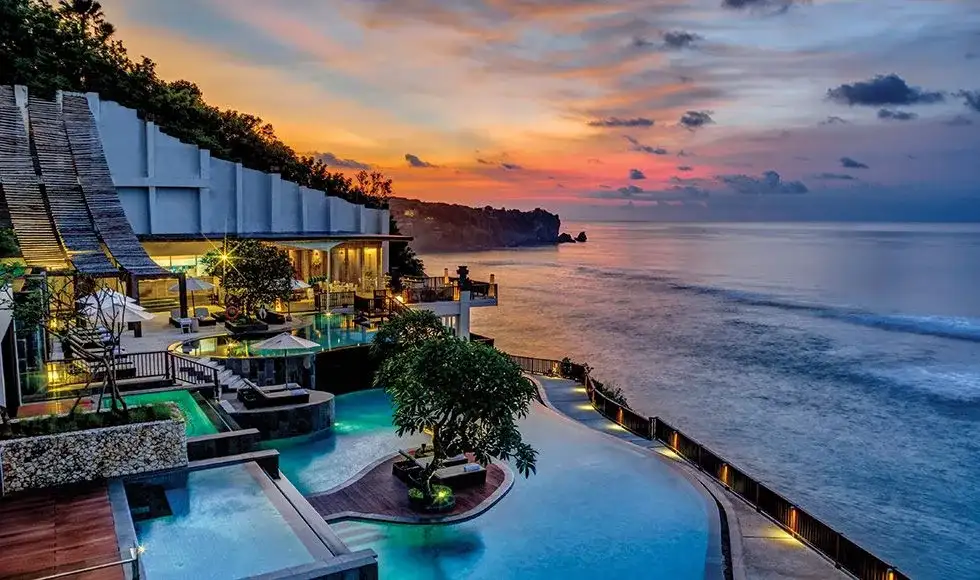
The Bukit Peninsula offers stunning ocean views and white sand beaches.
The quiet fishing village of Jimbaran lies on a narrow isthmus connecting the Bukit Peninsula to the rest of Bali. Jimbaran is unique in that it borders two different coasts lying less than two kilometres apart.
The geography around Jimbaran is distinctly different to the volcanic fertile soils found elsewhere in Bali. The Bukit Peninsula is comprised of a large limestone plateau offering stunning ocean views from its clifftops and white sand beaches. On the west coast is Jimbaran Bay and the Indian Ocean while the east has the shallow and sheltered Benoa Harbour. The region has remained sparsely inhabited due to the landscape and was at one stage a place of banishment where undesirables were sent. The Jimbaran area is a far less crowded alternative to Kuta or Legian thanks to careful planning by local authorities. The beauty of the beach has led to a number of luxury hotels being built along the shore. Budget accommodation is limited in Jimbaran, but the region is easily accessible from Nusa Dua or Kuta by taxi, bemo or bike.
The sea temple of Pura Luhur Ulu Watu is the region’s most significant sight. The temple is one of several dedicated to the spirits of the sea along the south coast of Bali. Precipitously perched atop sheer limestone cliffs, the temple is certainly a dramatic sight, especially at sunset. Sunset at Jimbaran Bay is another popular sight. Seafood restaurants and warungs line the beach and tourists arrive in the late afternoon to witness the brightly coloured fishing fleets prepare for departure.
An outlying reef protects the beach at Jimbaran quite well, however some of the world’s best and most dangerous surf beaches are located nearby at Uluwatu and Padang Padang.
The Garuda Wisnu Kencana Cultural Park (GWK) is situated overlooking the South Bali tourist region and is one of Bali’s premier venues for performances, exhibitions, conferences, sightseeing and relaxation.
Jimbaran has three major temples that draw tourists from around the world, Pura Dalem, Pura Puseh and Pura Desa. The anniversaries of the temples occur within four days of each other. At this time of year Jimbaran is vibrant and full of ritual activities. Although the number of tourists visiting Jimbaran is increasing, it’s still a relatively tranquil haven, offering many unique sights.
Uluwatu
Located on the western shore of the Bukit Peninsula on Bali’s southern coast, Uluwatu is famed for its spectacular rock formations, world-famous surf break, and dramatic cliffside temple.
Heralded ‘the most famous wave in Bali’ Uluwatu is a surfer’s paradise, however there is plenty of other things to see and do in Uluwatu for the non-surfer. Uluwatu boasts one of the oldest and most impressive temples in Bali, Pura Uluwatu, built by Javanese priest Empu Kuturan in the 11th century. Dedicated to the spirits of the sea, the temple is an architectural wonder, carved in black coral rock and perched high on the cliff side, 70 metres above the Indian Ocean. The best time to visit the temple is in the afternoon, so you can watch the evening traditional Balinese Kecak Dance and Fire Dance performance (held at 6pm every evening) on the cliffside stage as the sun goes down in the background. When visiting the temple, it’s advised to be mindful of your belongings, as the cheeky monkeys that reside here may take off with your sunglasses and hold them ransom in exchange for a banana!
This large limestone peninsula is just a short drive away from Kuta Bay, Jimbaran and Nusa Dua. Renowned for its spectacular sunset views its dramatic location, perched high on the cliff’s edge, provides the perfect locale to sit back, relax and enjoy the show.


